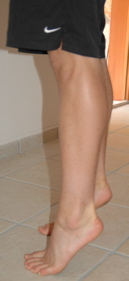It strengthens the calf muscles, especially the deep soleus muscle, which is vital for posture and balance, and which also has an important role in promoting good blood flow through the lower legs. Because it helps the circulation, it is a good exercise to use at intervals for improving the blood flow if you have to sit still for long periods, especially in an aeroplane. When you have to stand for a long time, it can help prevent fainting, because it prevents pooling of the blood in the leg veins. In older age, it helps maintain the leg strength needed for walking, especially up and down stairs or slopes.
Position: Stand by a support, such as a heavy piece of furniture, with your feet shoulder width apart, back straight, head up, neck and shoulders relaxed.

Movement: Raise your heels off the floor to go up on to the balls of your feet, keeping your toes relaxed, and tighten your thigh muscles to lock your knees straight. Hold for a count of 1, then lower your heels slowly with control, and relax your thigh muscles as the heels touch the floor.
Repetitions and frequency: 5-10 times, 2-3 times a day
Note: Avoid pain. Do not do this exercise if you have suffered cramps in the calf muscles recently. Make sure your weight is evenly balanced over both legs. If one leg is weaker, try to bring your weight over it slightly more than over the stronger leg. Keep the weight over the balls of the feet, do not let yourself over-balance towards the outer edges of the feet. Check that your toes are relaxed by lifting them slightly off the floor as you do the movement. Make sure your knees lock straight when the heels are raised. You may need to watch your legs in a mirror at first, to check whether the kneecaps move up and down as the thigh muscles contract and relax. Try to keep your knees straight as you relax the kneecaps. Breathe evenly throughout the movements, do not hold your breath.
After injury: Important after any injury to the leg, including bone fractures, especially in the shin-bone (tibia) or outer leg bone (fibula), ankle sprain, Achilles tendon rupture or strain, knee, thigh or hip problems. It helps correct the effect of a limp. Progression: When you can do the exercise easily, hold light weights in your hands. Keep your arms by your sides at first. When this is easy, hold your arms out forwards, so your hands are away from your body.


